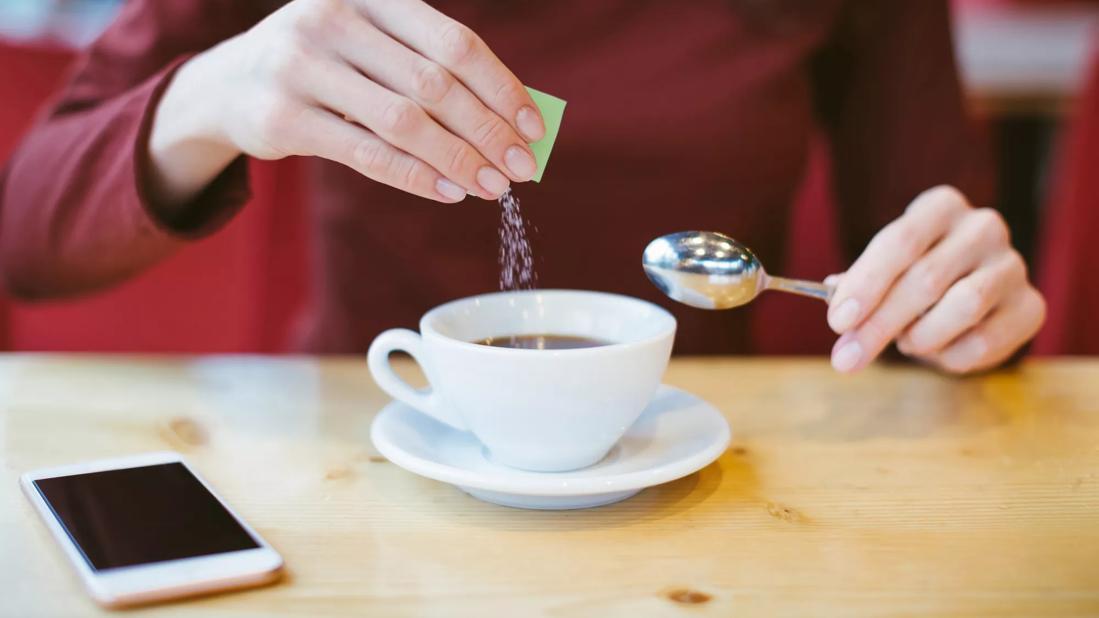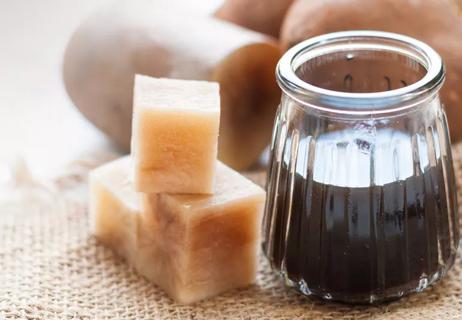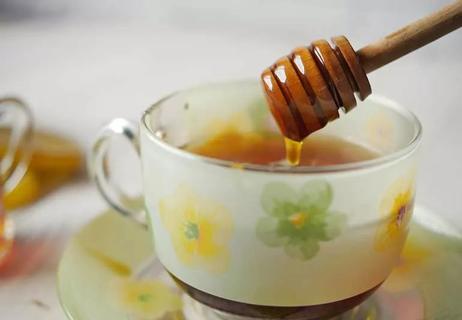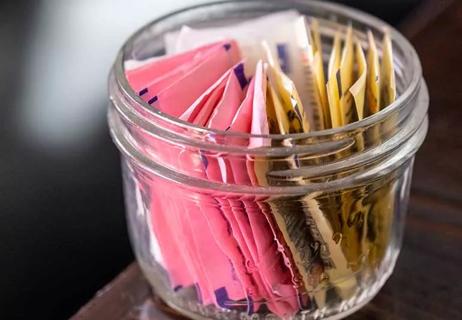Studies and the FDA say this herbaceous alternative is safe in moderation, so go ahead and sprinkle away!

Do you like tea or coffee but have kicked sugar to the curb? Have you broken up with artificial sweeteners like saccharin (Sweet n’ Low®), aspartame (Equal®) and sucralose (Splenda®)?
Advertisement
Cleveland Clinic is a non-profit academic medical center. Advertising on our site helps support our mission. We do not endorse non-Cleveland Clinic products or services. Policy
You still want to keep your sweet tooth satisfied. But how?
An herb called stevia might become your new best friend, and make treats sweet again.
“Stevia is my favorite calorie-free sweetener,” says registered dietitian Natalie Crtalic, RD, LD. “It’s a good alternative for people who don’t want to use sugars or other chemical sweeteners. In my opinion, using stevia is more natural than using other low-calorie, chemically processed sweeteners, like aspartame.”
The food industry uses the leaves of the stevia plant to make zero-calorie, zero-carb sugar substitutes. In the rainbow of packets in the grocery aisle or on the restaurant table, you’ll typically find stevia in the green ones.
But using sweet stevia isn’t new. People in South America have used this bushy, shrub-like herb’s leaves for centuries. Its history in the U.S. is a lot more recent, though. It received U.S. Food and Drug Administration (FDA) approval as an additive in 2008.
Stevia’s sweetness comes from something called steviol glycoside found in the leaves. And it’s up to 400 times sweeter than the main ingredient of refined sugar, sucrose. This means you’ll need a lot less stevia than sugar in your beverages or sprinkled on fruit.
Advertisement
| Sweetener | Examples of brand names | Times sweeter than table sugar (sucrose) |
|---|---|---|
| Acesulfame Potassium (Ace-K) | Sweet One®, Sunett® | 200 times sweeter. |
| Advantame | Advantame® | 20,000 times sweeter. |
| Aspartame | Equal®, Sugar Twin® | 200 times sweeter. |
| Luo Han Guo | Nectresse®, Monk Fruit in the Raw®, PureLo® | 100 to 250 times sweeter. |
| Neotame | Newtame® | 7,000 to 13,000 times sweeter. |
| Saccharin | Sweet and Low®, Sweet Twin®, Sweet'N Low®, Necta Sweet® | 200 to 700 times sweeter. |
| Steviol Glycosides (Stevia) | Truvia®, PureVia®, Enliten® | 200 to 400 times sweeter. |
| Sucralose | Splenda® | 600 times sweeter. |
| Thaumatin | Talin® | 2,000 to 3,000 times sweeter. |
| Sweetener | ||
| Acesulfame Potassium (Ace-K) | ||
| Examples of brand names | ||
| Sweet One®, Sunett® | ||
| Times sweeter than table sugar (sucrose) | ||
| 200 times sweeter. | ||
| Advantame | ||
| Examples of brand names | ||
| Advantame® | ||
| Times sweeter than table sugar (sucrose) | ||
| 20,000 times sweeter. | ||
| Aspartame | ||
| Examples of brand names | ||
| Equal®, Sugar Twin® | ||
| Times sweeter than table sugar (sucrose) | ||
| 200 times sweeter. | ||
| Luo Han Guo | ||
| Examples of brand names | ||
| Nectresse®, Monk Fruit in the Raw®, PureLo® | ||
| Times sweeter than table sugar (sucrose) | ||
| 100 to 250 times sweeter. | ||
| Neotame | ||
| Examples of brand names | ||
| Newtame® | ||
| Times sweeter than table sugar (sucrose) | ||
| 7,000 to 13,000 times sweeter. | ||
| Saccharin | ||
| Examples of brand names | ||
| Sweet and Low®, Sweet Twin®, Sweet'N Low®, Necta Sweet® | ||
| Times sweeter than table sugar (sucrose) | ||
| 200 to 700 times sweeter. | ||
| Steviol Glycosides (Stevia) | ||
| Examples of brand names | ||
| Truvia®, PureVia®, Enliten® | ||
| Times sweeter than table sugar (sucrose) | ||
| 200 to 400 times sweeter. | ||
| Sucralose | ||
| Examples of brand names | ||
| Splenda® | ||
| Times sweeter than table sugar (sucrose) | ||
| 600 times sweeter. | ||
| Thaumatin | ||
| Examples of brand names | ||
| Talin® | ||
| Times sweeter than table sugar (sucrose) | ||
| 2,000 to 3,000 times sweeter. |
Source: U.S. Food and Drug Administration Text Version of Sweetness Intensity of Sweeteners Compared to Table Sugar
Making stevia extract is like brewing tea. The goal? Get the steviol glycosides out of the leaves in the cleanest, purest form possible — an extraction. Processors steep stevia leaves in water and filter the solids from the liquid. After this, they filter solids and residues from the extract to get pure glycosides. These turn into a powder or granules through a special drying process.
The FDA has approved stevia as generally recognized as safe (GRAS) — but as a 95% pure extract. Some approved sweeteners made from this extract include:
Not all are 100% stevia. Some contain other chemical sweeteners or sugars — but also enough stevia to meet requirements. But Crtalic says if you want to use a sweetener that’s 100% stevia, it’s important to check labels.
“You always want to be sure you know what’s in there,” she adds. “Is it just stevia? Or are you OK with a combination of ingredients? If you want to stay away from sugar or chemical sweeteners, it’s important to look at what’s in your product.”
So, how much stevia is safe to use? Health officials use the phrase, “acceptable daily intake” or ADI to decide this. Using mathematical formulas, they determine how much edible substances are safe to consume daily across a lifetime. The FDA indicates that you’d need to down about 27 packets of stevia each day to hit the ADI. And remember, with a sweetness intensity of up to 400 times more than sugar, that’s a lot of stevia!
“As we further research it and get to know how it affects our bodies better, it’s important to use stevia in moderation,” Crtalic advises. “You don’t want to consume anything in excess, even if it is generally recognized as safe.”
And if you’re a pet owner and are wondering — stevia is non-toxic to dogs, cats and horses.
Researchers have examined this sweet leaf for more than 100 years. And they mostly agree that using stevia leaf extracts as sweeteners is generally safe. Some research has also found that stevia may have some health benefits.
A 2017 study says stevia is safe for people who have diabetes, obesity or high blood pressure. It notes that substituting stevia for sugar may even help prevent these conditions. Other studies have pointed out stevia’s potential as an antioxidant and for fighting inflammation. It may also help your kidneys work better.
To be clear, the FDA hasn’t approved stevia as a treatment for any health conditions. Whole stevia leaves, roots, stems and other parts (raw stevia) aren’t FDA-approved. The same goes for crude extracts (below 95% pure) and stevia supplements. Ask your healthcare provider before using stevia if you have a diagnosed medical condition.
Advertisement
It’s also important to understand stevia may have some drawbacks.
In a 2022 review of research on stevia and gut health, reviewers found studies had mixed results on whether stevia supports a healthy gut microbiome or causes an imbalance. A 2024 study found that it’s unlikely stevia harms gut health, at least during the 12-week study period. But that doesn’t rule out common side effects like nausea or bloating.
“There’s also some concern that it can trigger hormone disruption,” Crtalic notes. She’s referring to a study that came out in 2016. Health researchers continue to look into this claim.
If you want to stay sweet without refined sugar or chemical substitutes, stevia is worth a try. There are many different retail brands, so you can find one that suits your tastebuds, Crtalic says. Think about ingredients, aftertaste and even how it’s packaged.
“I never push anyone toward a specific product,” she continues. “I lay out the options to make sure you’re well educated. And then, you can make your own choice based on your needs.”
And when you find a stevia-based sweetener you like, it’s time to explore its possibilities. There are many ways to use it beyond morning coffee and tea. Love dessert? Give one of these recipes a try:
Advertisement
When cooking with stevia, you’ll want to keep this rule of thumb in mind: Look for recipes that offer measurements for stevia. You can’t just swap it for sugar. This can affect texture, not to mention taste.
“You’ve got to remember that stevia’s not a 1:1 substitute for sugar,” Crtalic says. “It’s a lot sweeter — and a little goes a long way.”
Advertisement
Learn more about our editorial process.
Advertisement

High fructose corn syrup is a common sweetener in packaged foods and can contribute to weight gain and inflammation

Erythritol is found in a range of ‘diet,’ ‘sugar-free’ and ‘keto-friendly’ foods — but research has linked it to heart attack and stroke

Although allulose is an FDA-approved sugar substitute, more research is needed to understand its safety

Xylitol in processed food can increase risk of heart attack and stroke — but there’s no danger in xylitol in oral care products

All-natural, plant-based and low-calorie, but it can also cause some serious digestive discomfort

Fruit is the best option for a healthy sweetener, but limit refined sugar and artificial sweeteners

Artificial sweeteners may have fewer calories, but they come with plenty of health concerns

Babies can get congested easily, but you can calm their cough by keeping them hydrated, using nasal drops and running a humidifier

Weight loss may cause loose, sagging skin and muscle loss to your rear

Several conditions, like vitiligo and fungal infection, can cause a loss of pigmentation, leading to white spots or patches on your skin